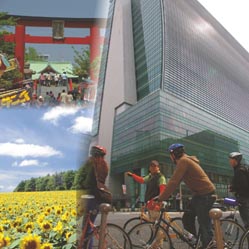Shimanami – Japan by bicycle
Program
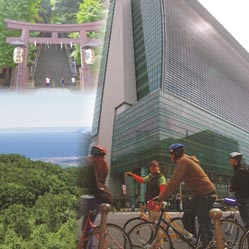
Day 1: Departure from London/Frankfurt
In the evening departure from Frankfurt/London and flight to Tokyo where you will arrive in the afternoon of the following day and take the connecting flight to Hiroshima. (time difference + 7h / summertime + 8h)
Day 2: Welcome to Japan!
Arrival in Hiroshima. Despite its sad history the city has developed into an important industrial location where there is among others one of the headquarters of the Mazda Motor Corporation. You will see with your own eyes on the next day that Hiroshima has a lot to offer beyond that.
Day 3: The gate to a divine world
On the third day of your Japan bike tour you are going to discover the most important sights of the city together with your tour guide. After a walk through the Peace park and a visit to the Peace Memorial Museum, you take the ferry to the island Miyajima where one of the best known symbols of Japan becomes visible:
The red Torii (shrine gate) of the Itsukushima Shrine seems to be floating on the water when the tide is high. This shrine with its buildings that stretch into the water is a true beauty in front of an impressing natural scenery. Together it represents a perfect ensemble of human creativity and natural beauty. The shrine was declared a UNESCO World Heritage Site in 1996.
The biggest building of the shrine complex is „Senjokaku“, which means pavilion of the thousand tatami mats. When you consider the floor area of 857 mats, it is understandable that this name referring to the size of the pavilion was chosen.
Day 4: To the islands
After you had a first impression of Japanese history and culture yesterday, we betake us to Onomichi, the starting point of our bicycle roundtrip.
Onomichi that is known for its many temples is a popular shooting location for the Japanese motion picture industry.
Here is also the initial point of the Shimanami-Kaido. Shimanami-Kaido is the nickname for the Nishi-Seto-clearway that was launched in 1999. It links Onomichi in Honshu with Imabari on the island Shikoku. The road has a length of 60 km and crosses 10 bridges and 6 islands of the Seto inland sea: Mukaijima, Innoshima, Ikuchijima, Omishima, Hakatajima und Oshima.
After a ferry crossing to the island Mukaijima, the ride on the Shimanami starts here for you. In former times this area was under control of the mighty Murakami family whose members first were pirates and up to mischief in this area and later served in the armies of several warlords.
You drive across the island Innoshima to get to Ikuchijima where you will spend your first night during the bike tour. An evening excursion to the romantic Sunset beach completes this day.
Day 5: Bridging the gap
After the breakfast you have the opportunity to explore with your tour guide the town of Setoda. You visit the Kosan-ji Temple that was built in the 20th century by the business manager Kanemoto Kozo in memory of his deceased mother. It represents an ensemble of replicas of different significant Japanese temples which styles are combined harmoniously. The most well-known reproduction is the one that imitates a famous gate of the Toshogu Shrine in Nikko - just one of the reasons why Kosanji is called „the Nikko of western Japan“.
After the visit, the Shimanami bike tour continues in the direction of Tatara Bridge. For bridge enthusiasts and those who are not yet, this bridge is a real highlight. With its length of 1480m it is one of the biggest cable-stayed bridges in the world. On the other side of the bridge awaits you the Tatara Shimanami Park on the island Omishima. You drive right through the impressive scenic island landscape to the Oyamazumi Shrine, one of the oldest places of pilgrimage in whole Japan. Allegedly its foundation dates back to the time when Japan’s legendary first Emperor Jimmu came to power. It is stated that Oyamazumi is home to a tutelary deity of the sea and the mountains. Furthermore the shrine became in the course of the year a pilgrimage destination for many generals that hoped for victorious battles by praying to the local deity. When they succeeded, many of the soldiers came back and brought with them their armour or weapons as a gift or tribute to the deity. Apparently their prayers were answered since the shrine possesses over 80 % of the historic armors that are classified as national treasures or significant cultural assets.
Day 6: Pirate stories
On the 6th day of the Japan travel the bike trail continues over the Omishima Bridge on to Oshima where you will pay a visit to the Murakami Suigun Naval Museum. Learn something about the history of the once-mighty pirate family Murakami and try on a real Samurai armour if you like to!
Later on you have the possibility to enjoy the spectacular view from the Kurushima Kaikyo Bridge, another highlight of the Japanese bridge building architecture. It is composed of three strung together suspension bridges and has a total length of 4015 m. After crossing it, you reach Imabari and therewith the end of the Shimanami-Kaido.
We will make a short stop here and enjoy the impressive view from Itoyama Park onto the Kurushima Kaikyo strait, before we head on to the hotel. On the way to it is situated the Imabari castle that was originally built in the 17th century by feudal landowner Todo Takatora. It is one of three „Mizujiro“ in Japan that literally means „water castle“. During the Meiji reign in the 19th century the original buildings inside the fortress were destroyed. In 1980 the town of Imabari built a new residential tower that overviews the sea in its entire splendor.
Day 7: Pilgrim spirit
You are now on Shikoku, the smallest of the four main Japanese islands. Shikoku is known in particular for its 1200 km long pilgrim’s path, the Shikoku Hachijuu Hakkasho, which could be translated by „The 88 places of Shikoku“. This path is one of the most important pilgrimage routes in Japan. According to legend, it has supposedly been founded by the monk Kukai, the originator of the Buddhist Shingon School.
The pilgrims on this path, the so-called Henro, can be recognized by their white dresses, pointed hats made of sedge and their pilgrim’s staff. Although the way is supposed to be walked some modern pilgrims use the car, busses or even the bicycle. Maybe you encounter one of them on today’s ride from Imabari to Niihama.
Day 8: Off to Kanonji
On 8th day of your Japan travel we continue the beautiful route of the pilgrim’s path alongside the Seto inland sea and arrive in Kannonji in the afternoon.
Since we were riding the bike almost every day for the last week there is going to be a resting day tomorrow. Seize the opportunity to relax a little and to discover calmly all the beauties and sights worth seeing of the region.
Day 9: Sand pictures
This morning the tour guide gives you free time so you can explore the surroundings on your own. How about a stroll in Kotohiki Park? Go on a time travel through the history of this region for instance by taking a look at Zenigata. It is a gigantic picture in the sand of a coin from the Edo period that is called „Kan-ei-Tsuho“. It is told that the residents of this region had built this in 1633 in only one night to welcome the then ruler Ikoma Takatoshi. Allegedly everybody that takes a look at the picture will be blessed with good health, a great age and always enough money in the pocket. The 2km long beach Ariake is a popular spot for bathing or promenading and it offers a captivating view onto the Seto inland sea.
In Kotohiki Park is also located the Kannonji Temple and Jinne-in Temple, two stops on the Shikoku Hachijuu Hakkasho pilgrim’s path. The afternoon will be relaxing as well as you will see. The tour guide takes you to one of the famous Japanese Onsen baths. Well rested we will go on to the next stage tomorrow.
Day 10: Konpira-san
Today’s bicycle tour leads you to the Kanamaru-za in Kotohira, the oldest Kabuki stage in Japan that is still played on. It was built in 1835 but passed into oblivion after Japan’s opening in the mid-19th century. It was rediscovered in 1970. In the restored building that is classified as an important cultural asset, the backdrop, lighting, stage craft and the seats are still the same as they were in the 17th until the 19th century.
Next stop is one of the most popular shrines in whole Japan, the Kotohira-gu or „Konpira-san“, as it is called in common parlance. Since many centuries people come here to ask the shrine’s tutelary deity for assistance. The ascension to the main hall over 785 steps leads in the lower area past numerous souvernir shops that offer different goods such as sweets, masks, pottery or woodcarvings. The main hall Omote-Shoin originates from the 17th century and contains a collection of beautiful Fusumas, the painted sliding doors that were designed by Maruyama Okyo, one of the greatest artists of the Edo period. Later on they were declared a Japanese national cultural asset.
After a stroll through Kotohira we continue the tour and go to Zentsuji, the birthplace of the monk Kukai or Kobo Daishi as he was called after his death. You visit Zentsuji Temple where you are going to stay the night.
Day 11: Samurai town Takamatsu
For the early birds the day starts with something special. If you like, you have the opportunity to participate in the monk’s prayer ceremony.
After that we get on our bikes and ride to the modern city of Takamatsu. It had its prime during the Edo period in the 17th century under the rule of the Matsudaira Samurai clan. One of the most beautiful landscaped gardens was also in its possession - the Ritsurin Park. Enjoy the beauty and superb design during a walk in the park and taste a cup of tea in the nearby tea house if you like!
Subsequently you have some free time at your disposal. We recommend visiting Japan’s longest shopping arcade or getting to know the local cuisine: The prefecture Kagawa is famous for Udon, thick noodles made of wheat flour that were even shot on a very popular film a couple of years ago. Maybe you will also get enthusiastic about this local delicacy…
Day 12: Welcome back to Honshu
You leave the island Shikoku by taking the ferry from Takamatsu to Uno. Back on dry land we hop on our bikes and drive to Okayama. In Okayama we will visit the two well-known sights of the city. This would be at first the 1573 built castle that is nicknamed Crow Castle because of its black exterior. Secondly we will visit the Koraku-en garden, one of the three Great Gardens of Japan. Feel free to stroll around enjoying the peace and the beautiful scenery!
Day 13: Himeji
The Himeji Castle, also called „the White Heron“ because of its white walls, was taken over by Toyotomi Hideyoshi, one of the three unifiers of the empire, in 1580 and was considered invulnerable from then on. It has been a national cultural treasure for a long time and was declared UNESCO World Cultural Heritage Site in 1993.
Day 14: Kyoto - the millennial capital
The former capital Kyoto is Japan’s cultural and historical centre. You visit first the Imperial Palace with its striking architecture and the rock gardens. Afterwards we want to walk with you on Philosopher’s path, a scenic path lined with cherry trees and different temples we are going to visit. The Nanzenji Temple entices a lot of visitors especially with its scenic garden and the impressive wooden main gate. Not far from it is Ginkakuji, the Temple of the Silver Pavilion, one of the most famous Zen temples in Japan. Next stop in Kyoto is the well known Kiyomizudera Temple.
Kiyomizudera means „Temple of Clear Water“. It is located on a hill and has a giant wooden terrace from where you can enjoy the view onto the city.
The temple was founded in 780 AD and is connected with the Hosso School, one of Japan’s oldest Buddhist schools. Under the famous wooden terrace you can taste the eponymous clear spring water. It is said to have medicinal properties.
Day 15: Kyoto by bike
On this day we explore the city of Kyoto by bike. First stop is Nishijin textile centre where we will able to enjoy a Kimono fashion show. The sparkling colours and soft silk will take you to another world.
The Nijo castle in the western part of Kyoto is the former Shogun residence. It was built in the early 17th century by Tokugawa Ieyasu and has some interesting features like the painted walls and sliding doors as well as the „nightingale floors“, an innovative alarm system.
Afterwards you will ride our bikes to the scenic Arashiyama, a popular recreational area near Kyoto. We invite you to take a walk in the bamboo grove and visit the Tenryuji Temple and its landscaped garden that is in its original shape from the 14th century. Finally we go to Mt. Iwatayama, the monkey hill and enjoy the panoramic view onto the city of Kyoto.
Day 16: Off to Tokyo
In the morning you will take the high-speed train Shinkansen from Kyoto to Tokyo, the exuberant Japanese capital. Enjoy the view during the relaxing train ride.
Your hotel is situated in the lively Asakusa quarter that is near the famous Kaminari-mon, the „Thundergate“. When you pass its gigantic red lantern you find yourself on Nakamise, a market street where you can buy all kinds of traditional sweets, dishes, toys but also fabrics and clothes. The Nakamise leads to Sensoji, the temple also known as Asakusa-Kannon. It was founded in the 7th century when, according to the legend, two fishermen found a Kannon statue in the river.
In the following you take the boat to go to the innercity Hama-Rikyu garden and have there the opportunity to take a break in a tea house that is located on one of the sea water fed lakes in the park. After a short train ride with the fully automated, driverless train „Yurikamome“ you arrive to one of the most modern neighbourhoods of Tokyo: Odaiba. This artificial island in the Tokyo Bay is a shopping and entertainment district. It is linked with the city centre by the Rainbow Bridge and offers a beautiful view onto the city.
Being on a visit to Tokyo, you cannot miss a stroll across Ginza. It was built by two British architects at the end of the 19th century who took Paris as a design model. Today it is one of the most exclusive shopping miles of whole Tokyo.
Day 17: Fresh fish and crowded streets
The seventeenth day of your Japan trip starts with a visit to the world’s biggest fish market, Tsukiji. On the way to it, everything is sold what is needed for the draught, processing and consumption of the fish. Right here you will also get the freshest Sushi of all Japan.
Afterwards you will be going on a tour through Ueno Park, Japan’s first inner-city park. It is home to some prestigious art museums as well as the Tokyo National Museum.
Just a couple of steps away is the busy marketplace of Ameya-Yokocho. Walk across this rustic shopping place and try some of the provided delicacies if you like.
Subsequently a tour around the streets of the electronic-quarter Akihabara that are enlightened by a vast number of neon signs awaits you. This quarter has developed to the centre for entertainment electronics. Since a couple of years the Manga-, Anime- and Cosplay scene has settled here as well.
After that we have planned a visit to Shibuya. The memorial in honor of Hachiko resembles a dog that waited for his owner every day at this exact spot, even after his death. It looks upon one of the liveliest crossroads of Tokyo which is crossed by thousands of people at the same time when the traffic light is green.
The next thing we want to show you is the famous Meiji Shrine. The shrine which is dedicated to the Emperor’s couple is considered as a classic example of Shinto architecture. During the New Year’s holiday this is one of the most visited places of the country.
For finishing the day we drive to Shinjuku, the business quarter. „The sky is the limit“ is the mantra when you climb up one of the skyscrapers of the Metropolitan Government Building Observatories. You have a magnificent view onto the city from the 45th floor.
It is time to reminisce about the tour that started on a bicycle saddle and now ends on top of this mesmerizing metropolis.
Day 18: Goodbye Japan
Today it is about time to say goodbye to Japan (but only for this time). Take a last look on the busy metropolis out of the plane before you will arrive in your home country in the evening.
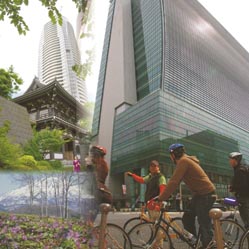
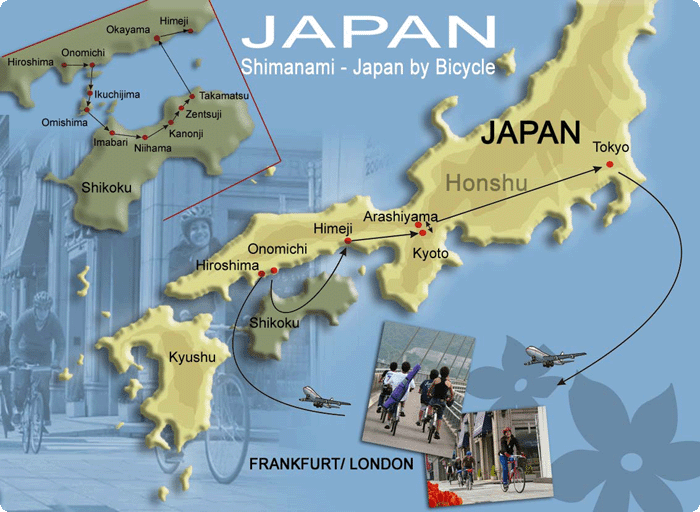
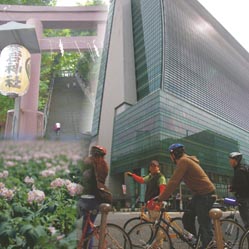 Features
Features
